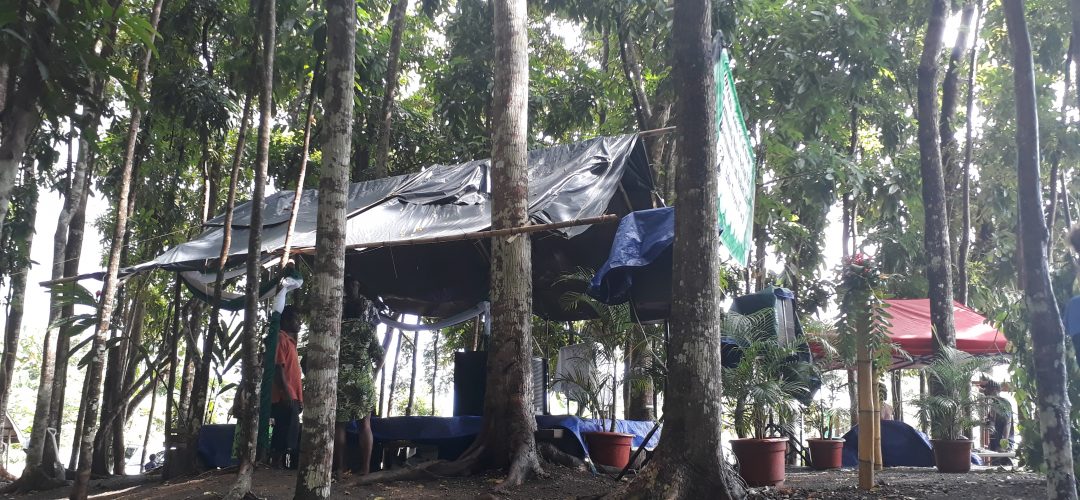First-hand encounters inspire USP journalism news team on climate change reporting assignment

The Barana Nature and Heritage Park is a milestone for community-based conservation in Solomon Islands. Activities include reforestation to reduce flood risks, replanting of stream or watershed areas to reduce soil erosion and sustainable land-use management practices. Picture: ROSALIE NONGEBATU/WANSOLWARA
By GERALDINE PANAPASA
Hearing first-hand the experiences of Solomon Islanders directly affected by climate change on a regular basis was an overwhelming experience for three final-year journalism students from The University of the South Pacific in Suva, Fiji.
The students, Rosalie Nongebatu, Ben Bilua and Romeka Kumari, were part of the environmental reporting team that travelled to the Solomon Islands capital, Honiara, last month. The trip was sponsored by the Internews/Earth Journalism Network (EJN) Asia-Pacific 2019 media grant.
Nongebatu, a Solomon Islander, said the trip offered the students an opportunity to go out into the communities affected by climate change, and write reports based on the experiences of grassroots people as related by them.

“Climate change and environmental issues are under-reported. This includes the experiences and concerns of the communities living with the everyday realities of climate change, which are swept under the carpet for hard news and headline stories in sports and politics,” Nongebatu said.
The reporting team did their research beforehand to identify areas in Honiara affected by climate change, prior to spending a week in Honiara, talking to the communities about their hardships, hopes and aspirations.
“A community chief we spoke to was very happy with our visit, saying that changing weather patterns were changing the way the community lives, forcing them to be more resilient and resorting to some to traditional means to adapt to the changing conditions,” said Nongebatu.
For instance, the community at Vatukola Village in Kakabona, west of Honiara on Guadalcanal, are now using dugout wells after dams and water sources started drying up as a result of prolonged dry weather.
Solomon Islands, with a population of 642,000, is one of the hardest hit by climate change, compounding other environmental and developmental challenges that the country has faced.
Ranked fourth among 15 countries with the highest disaster risk in the World Risk Index 2018 Report, Solomon Islands is particularly affected by sea-level rise and cyclones and like neighbouring Melanesian country Vanuatu, it is unable to reduce the disaster risk without external support.
USP Journalism coordinator Dr Shailendra Singh said a lot of coverage on climate change in the Pacific media was based on regional and international meetings, and workshops and speeches, with prominent politicians, climate scientists and experts taking centre stage, disseminating information based on complex research, that sometimes failed to strike a chord with the people.
“Talking directly to the people produces a more compelling and relatable account of the manifestations of climate change on daily life based on first-hand experiences. These are the people who are directly affected, yet they hardly get a chance to have their say in the news media,” said Dr Singh.
The communities the USP journalism reporting team visited were willing to share their views about their water sources drying up, depleting fish stocks and lack of food gardens, and how they used traditional practises to mitigate some of the impacts.

USP Journalism teaching assistant Geraldine Panapasa, who headed the reporting team, said the students were able to apply their journalism production skills in print, online and broadcast. Part of the field reporting training included mojo (mobile journalism) skills for short news videos, conduct by EJN.
Panapasa said it was good to get the students away from the classrooms and computer screens to talk to people directly, and record their experiences.
“We were able to focus our reporting on the overall theme of the project, ‘Adapting to and mitigating effects of climate change and island sea level rise’,” said Panapasa.
“We visited vulnerable communities in the greater Honiara area, spoke to those at the forefront of climate change, those in resilience and adaptation projects, and those in decision-making positions and the future generation. I could tell that the students were moved by the experience.”
Panapasa said they encountered a number of concerning aspects on this assignment.
“One was the expectation in some communities that studies/reporting of climate change was a money-making opportunity. Some chose to speak to us about their experiences only if we paid them money.”

The trip was made possible by a competitive $US20,000 ($F42,617) grant from Internews/Earth Journalism Network (EJN) Asia-Pacific 2019 media grants.
The EJN sees the grant programme as an opportunity for media, civil society organisations and academic institutions throughout Asia-Pacific to think critically and creatively about how to build local resources for reporting climate change, natural resource management and the environment.
The USP Journalism Programme, which started in 1988, has seen well over 200 graduates serving in various media and communication roles in the Pacific and beyond.
The programme has won a number of national and regional awards for environmental reporting, including the 2010 Vision Pasifika Climate Change Media Awards by the Secretariat of the Pacific Regional Environment Programme (SPREP).











